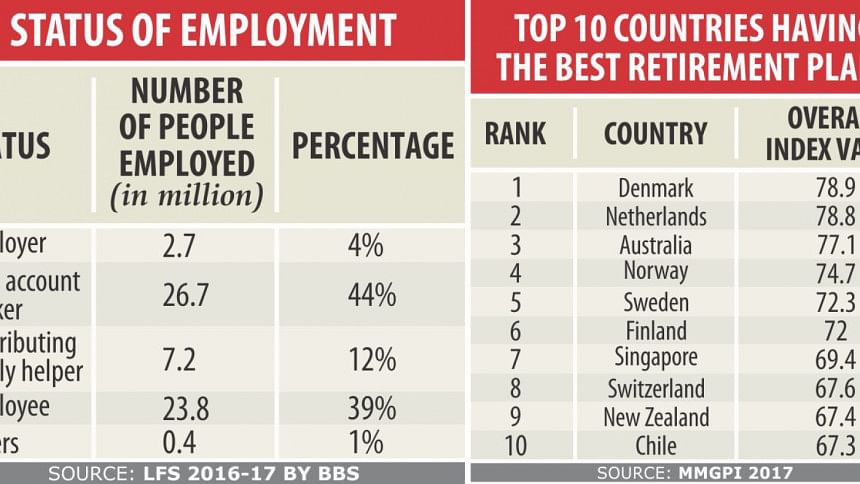Its time to ensure pension for all

While crossing the mighty Padma by a Ro-Ro ferry I met Kabir Bhai who was at his late 50s working there for the last 26 years as a master roll staff and counting his days for retirement. Sitting in the nice cozy cabin on the top of the ferry I was enjoying the gentle breeze, the beautiful surroundings with a steaming cup of tea. Within a short time, our conversation turned into some serious discussions. Suddenly, I noticed something in his eyes and heard a voice full of uncertainties! He was not sure how the time would greet him after his retirement! How would he be able to keep the wheel of his life moving?
Kabir Bhai is not alone. There are millions who devote their best part of lives by working day and night still unable to secure an assured future!
Bangladesh is presently blessed with a huge number of young people. The median age of the inhabitants of this young country is 26. More importantly, around 60 percent of the people fall under the category of 15-64 age bracket known as the working age. However, the age structure is going to be changed with the course of time. It is estimated that by 2030 there will be about 21 million people in the country who will be 60 years of age or more.
The number of elderly population is projected to be more than double by 2050! In this context, a critical question to be asked: how many of them, the senior citizens of the country, will be financially secure then? Considering the lack of adequate social security system, the answer would, unfortunately, be “not many”! This financial insecurity is going to cause a serious potential threat to the overall social safety net of the country.
According to the Labour Force Survey Bangladesh 2016-17 (LFS) conducted by the Bangladesh Bureau of Statistics (BBS); the total workforce in the country is roughly 60.8 million.
The table portrays an alarming picture from the perspective of economic risk and vulnerability. 56 percent of the total workforce belonging to the group of “own account worker” or “contributing family worker” are considered as the most vulnerable section as they don't have any formal employment contracts and consequently are deprived of any kind of after-service benefits. We must not assume that everyone else of the rest of the groups is fortunate as fewer of them are under some sorts of retirement coverage.
The pension is a proven and widely used tool across the world to ensure social security. Currently, the government employees of the country have the pension plan in its true nature.
There are a few private organisations that provide some retirement benefits like provident fund (PF), gratuity, super annuities in different combinations, meaning some companies offer all three, a few of them provide only gratuity while some organisations offer both PF and gratuity.
However, a vast majority of the workforce is out of the purview of pension!
There are obviously inherent challenges given the way pension schemes offered by the private sectors are managed. First, there is no unique way of managing those plans. Some companies administer the funds by an independent board of trustee while there are organisations that don't follow the fund concept. These funds are independent.
As a result, if an employee leaves an organisation, their membership of that fund ceases immediately. The employee needs to restart the whole process with the new organisation in accordance with the new employment contract. The terms and conditions also vary from organisation to organisation.
It is apparent and a high demand of the time that, something needs to be done to streamline and initiate a progressive pension system in Bangladesh. Luckily, we don't have to reinvent the wheel as there are many best practices around us, even in the neighboring countries.
Mercer, one of the reputed HR consulting firms, along with the Australian Centre for Financial Studies of Monash Business School, conducts a research to benchmark the national pension systems across the globe. An index known as Melbourne Mercer Global Pension Index (MMGPI) is used to analyse and compare different pension systems based on their adequacy, sustainability and integrity. According to the 2017 report, Denmark was ranked first in the list followed by the Netherlands and Australia. Singapore scored the highest in Asia with a global rating of seven. India has also shown good improvement, rank 6th in Asia and 28th globally.
Let's further dig down how pension system is managed in Singapore and India. In Singapore, the pension plan known as the Central Provident Fund (CPF) is a mandatory savings scheme for all working Singaporeans along with the permanent residents funded by both the employers and the employees with the clear objectives to meet their retirement, housing and medical needs. The Singapore government also contributes to supplement the CPF savings of lower wage workers and top-ups for senior citizens for their medical services. This scheme also allows a self-employed person to contribute and get the benefits afterward. This fund is managed by a government body known as the Central Provident Fund Board under the Ministry of Manpower.
In India, there are multiple pension schemes available like the Employee Pension Scheme (EPS) and the National Pension Scheme (NPS). The EPS ensures a guaranteed monthly pension after the retirement for the employees of the organised sector as defined by the law. The family of the employee also gets the pension after the demise of the employee. Both the employee and the employer contribute at the rate of 12 percent of the basic wages and dearness allowance, if any, per month. The government contributes 1.16 percent of someone's basic pay in the pension account.
The entire 12 percent of an employee's contribution is added towards the employee provident fund (EPF), while 8.33 percent out of the total 12 percent of the employer's contribution is diverted to the EPS and 3.67 percent is invested in the EPF. This fund is managed by a statutory body – the Employee Provident Fund Organisation.
The NPS is a government-sponsored pension scheme for any citizen of India aged 18 to 60 years. Anyone can contribute regularly to a pension account during their working life and this money is invested and the return is usually high.
Later, the subscriber can withdraw a part of the corpus in a lump-sum and use the remaining corpus to buy an annuity to secure a regular income after retirement. The Pension Fund Regulatory and Development Authority manages the scheme.
We saw the light at the end of the tunnel when the policy-makers, especially the finance minister talk about introducing a universal pension scheme for all citizens of Bangladesh. We hope that this all-important topic doesn't get lost in the midst of many priorities or in so-called bureaucratic process. The sooner the better.
The writer is chairman and managing director of BASF Bangladesh Ltd.

 For all latest news, follow The Daily Star's Google News channel.
For all latest news, follow The Daily Star's Google News channel. 



Comments